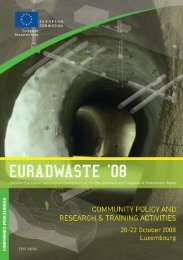EU industrial structure - EU Bookshop - Europa
EU industrial structure - EU Bookshop - Europa
EU industrial structure - EU Bookshop - Europa
You also want an ePaper? Increase the reach of your titles
YUMPU automatically turns print PDFs into web optimized ePapers that Google loves.
ox II.4: SME definition<br />
FIgURE II.7: Distribution of value added by enterprise size in 2007 (%)<br />
Tobacco<br />
Communications<br />
Mineral oil rening and nuclear fuel<br />
Motor vehicles<br />
Air transport<br />
Other transport equipment<br />
Electricity, gas and water supply<br />
Radio and TV equipment; electronic components<br />
Basic metals<br />
Chemicals<br />
Oce machinery<br />
Electrical machinery<br />
Pulp, paper and paper products<br />
Research and development<br />
Supporting transport activities<br />
Food and drink<br />
Machinery and equipment n.e.c.<br />
Scientic and other instruments<br />
Non-metallic mineral products<br />
Retail trade<br />
Rubber and plastics<br />
Computer and related activities<br />
Inland transport<br />
Printing and publishing<br />
Water transport<br />
Other business activities<br />
Furniture; other manufacturing<br />
Clothing<br />
Textiles<br />
Renting of machinery and equipment<br />
Hotels and restaurants<br />
Wood and wood products<br />
Wholesale trade<br />
Fabricated metal products<br />
Sale and repair of motor vehicles<br />
Leather and footwear<br />
Construction<br />
Recycling<br />
Real estate activities<br />
MANUFACTURING<br />
SERVICES<br />
TOTAL ECONOMY<br />
Source: own calculations using Eurostat data.<br />
II.4 Services output of<br />
manufacturing<br />
An increasing number of manufacturing firms offer services<br />
along with their traditional physical goods. This tendency<br />
is coined ‘convergence process’ in the literature. 36 By<br />
offering complementary services manufacturing, firms<br />
can differentiate their products from the competitors’ and<br />
reduce price elasticities for their goods. Complementary<br />
services may also be a way to increase the qualities of the<br />
36 European Commission, DG Enterprise and Industries (2011)<br />
forthcoming. European Competitiveness Report 2011.<br />
Chapter II — Changes in <strong>EU</strong> Industrial <strong>structure</strong><br />
Enterprises qualify as SMEs if they meet certain employee ceilings (10, 50, and 250 employees) and one of the two<br />
financial ceilings (turnover or balance sheets).<br />
Eurostat currently collects data regarding the three employee ceilings but not data concerning the financial ceilings.<br />
1–9<br />
10–19<br />
20–49<br />
50–249 250 or more<br />
0 10 20 30 40 50 60 70 80 90 100 110<br />
goods and build long term relationship with customers<br />
which also might reduce the price elasticities the firms are<br />
facing. Opening up additional sources of revenue could be<br />
another motive. 37<br />
Services as shares of total manufacturing output increased<br />
in all but three <strong>EU</strong> countries between 1995 and 2005. Largest<br />
shares are found in the Finnish and Dutch manufacturing<br />
industries where services constitute around 8 % of total<br />
output, cf. Figure II. 8.<br />
37 Ibid.<br />
51
















